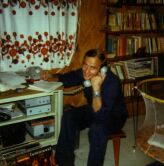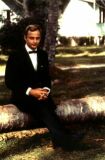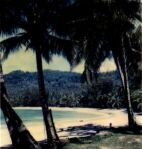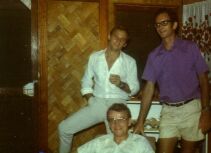At around 15 years of age, my parents and I went to Iran for two years. The Shah was still in power. One year was spent in Teheran, one year in central Iran - a place called Kuh-dasht. My dad was in charge of building American military installations and also a road across Luristan. When he was taken ill I had to take my mother 380km back through the desert to Teheran past smugglers and bandits (I had my dad’s 9mm Walter on top of the eski). As it is well known, women didn’t mean anything at that time. I was too young to hold a drivers license, so I had to find a driver. We subsequently went to Switzerland where we bought a house. I did my matriculation and became a commercial pilot. I was the first private pilot who completed, with only 40 hours' experience, a circumnavigation of the Mediterranean in a single-engine Piper Cherokee in winter. Life got too boring in Europe and I emigrated to Australia, First Class Archille Lauro and landed in Fremantle. I worked as a navigator on geophysical flights in WA and South Australia. I saw an ad in the paper: Riggers wanted in Bougainville. Didn’t know what a rigger was supposed to be but the name Bougainville was good enough. In I went, still with the European attitude and suit, sat down and was interviewed. "We will let you know" was the answer. I thought - ah well… . Three weeks later I received a telephone call: "'We would like to offer you the position of Store Supervisor with Johns & Waygood on Bougainville." What could I say? After all, I had planned South Pacific expeditions since I was a kid. Due to the time delay and shortfalls in income, I worked as a factory cleaner for three weeks in one of J&W’s establishments in Adelaide before I flew out to Kieta. Camp 1 was my first stop. Looked good. Had my tape recorder with classical music and earphones to shut out, what I called then, “the roughies”. Settled down in the job, which entailed supplying 360-odd persons from J&W, with everything they needed. One night, while in the donga, there was a knock on the door, and the previous Store Supervisor, Brian, popped his head in and said ‘good-night’ - strange! He was found next morning inside a ute with a hose connected from the exhaust pipe to the cabin, dead! As part of my job I had to organize the trans-shipment of construction steel, beams etc. from the lay-down area in Camp 6 to Panguna. Roads were not sealed at that time. Naturally, crotch-rot sat in. Full iodine etc. and it only got worst. Couldn’t walk but had to. After clearing the steel I went back to camp 1. I had a girl in WA that I wanted to marry. Tony Brown was the only one of the company who had his wife with him. So, I started to pester Tony and Mr. Hooper until they made married accommodation available. Lyn came up, Life trundled on with lots of fun and parties until the time the actual mine construction was completed and J&W’s contract expired. In 1974 I became a naturalized Australian. I think it was the magistrate at Arawa, David Moorhouse, who administered the oath. Frank Tonon and I built during that time a 36ft motor cruiser - after all there were sufficient components left over to do so. She was launched in Loloho and the ballast was - guess, yes - milling balls. We named her ‘Flounderer’ and actually planned to sail her back to Aussie. Thank God, we didn’t. She was modified several times and we all had a ball going out on Friday afternoons, back on Sunday afternoons. We found and dived on wrecks, brought up memorabilias. One of them was an anchor, located in the engine from one of the vessels sunk around the corner from Kieta, which we donated to the Davara. We brought back Betty bomber propellers which I cemented in the ground near the workshop at Aropa, etc. I must pay a compliment to the "roughies": Many times my wife was the only female on board, bikini and all, but they all behaved like real gentlemen, unlike Mr. Hooper, who wanted to get into her pants. Meanwhile, I sent all equipment back to Aussie and my wife and I moved into the Flounderer. It was a great time. We met many yachties from all over the world while at anchor in Loloho and at the Kieta Yacht club. I got a job with BCL at the port - supervising ship loading. Steeldeck. Camp 5 needed an assistant manger - I got the job and we lived in a sack-sack for about six months - until that contract also came to an end. My wife did the catering for Air Niugini from the plantation and we met some fascinating people, including Steve and Willy from the Davara. I set up a marine-biological lab on the plantation for local kids and started my photography. The pictures sold well, locally and overseas. The plantation house was a large building right on top of a big hill, overlooking the ocean with a
 My years on Bougainville from 1970 to 1979 were some of the most mind- and character-forming in my life.
My years on Bougainville from 1970 to 1979 were some of the most mind- and character-forming in my life.
 we got married at Koromira Mission at 6am and Lyn was subsequently employed as well. After the wedding we hired a boat with food to go out that day. Lyn’s best man was a German by the name of Karl. He was a senior engineer with J&W. One of the most inventive persons I ever met. In every nook and cranny of the site and under his hat he had a few beers stacked away - no wonder he inspected every nook and cranny all day long. When being out the boat we took a dinghy to Koromira Atoll. Naturally Karl had to stand up, capsize the boat and we lost all our wedding films. Otherwise a great day! Re-shot the ‘scene’ one year later without him - he was gone.
we got married at Koromira Mission at 6am and Lyn was subsequently employed as well. After the wedding we hired a boat with food to go out that day. Lyn’s best man was a German by the name of Karl. He was a senior engineer with J&W. One of the most inventive persons I ever met. In every nook and cranny of the site and under his hat he had a few beers stacked away - no wonder he inspected every nook and cranny all day long. When being out the boat we took a dinghy to Koromira Atoll. Naturally Karl had to stand up, capsize the boat and we lost all our wedding films. Otherwise a great day! Re-shot the ‘scene’ one year later without him - he was gone.
 Then I heard that Aropa Plantation was looking for an engineer. Got there, was shown around and I said I can do the job. I had a little Isuzu truck at that time. So when getting back in the truck with the manager, the car wouldn’t start - dead to the world. He said, "OK, if you can get the truck started, you've got the job." I jumped out, twisted the battery terminals and, bingo, I had a job. I stayed with them for over three years. Aropa was then the second or third largest plantation on the island. We were three whities and about three hundred 'bois'. Had many challenges from mist blowers to D8 dozers.
Then I heard that Aropa Plantation was looking for an engineer. Got there, was shown around and I said I can do the job. I had a little Isuzu truck at that time. So when getting back in the truck with the manager, the car wouldn’t start - dead to the world. He said, "OK, if you can get the truck started, you've got the job." I jumped out, twisted the battery terminals and, bingo, I had a job. I stayed with them for over three years. Aropa was then the second or third largest plantation on the island. We were three whities and about three hundred 'bois'. Had many challenges from mist blowers to D8 dozers.
180-degree view. Pure magic! (I've tried desperately to find pictures of the now burned down houses - can anyone help?). After three-and-a-half years, we left Aropa and I became sales manager for Ela Motors, increasing sales from 30 to 70 units/months. I left them, managed Toboroi for about six months, and subsequently worked at Raua Plantation as a mechanic. We had two kids by then, born in Kalgoorlie and Brisbane, and it was time to break up camp. We had been there during self-government and Independence and could feel a "change of climate" coming on. Our feelings were proven right and we returned to Australia in 1979.
 In my opinion, the difference between Bougainville and ‘the rest of the world’ is that there existed on the island a sense of joy, excitement, action and that little twinge of danger added as a spice. One was alive and to really feel alive is something one can never forget. It incites a craving that, unfortunately, can never be stilled again. Like-minded people met. There was peace. To go back there now, I feel, would be too sobering for me and anger could dominate and destroy my good and creative memories.
In my opinion, the difference between Bougainville and ‘the rest of the world’ is that there existed on the island a sense of joy, excitement, action and that little twinge of danger added as a spice. One was alive and to really feel alive is something one can never forget. It incites a craving that, unfortunately, can never be stilled again. Like-minded people met. There was peace. To go back there now, I feel, would be too sobering for me and anger could dominate and destroy my good and creative memories.
From the Blog Editor:
John, your last paragraph is an excellent summing-up of the memories many of us have of those early days on the island.
Peter Goerman